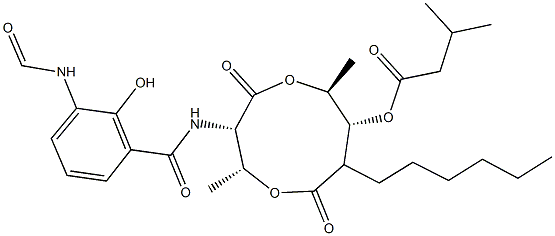Antimycin (A3 C26H36N2O9) and (AntimycinA1) C28H40N2O9 are crystalline solids. Molecularweight= 512.8 (A); 520.64 (A3-); 506.6 (A4-); Freezing/Melting point= 170°175℃; 149°150℃ (A1); 174°175℃(A3). They are complex 9-membered (2 oxygens and 7 carbons) ring derivatives with complex side chains. HazardIdentification (based on NFPA-704 M Rating System):Health 3, Flammability 0, Reactivity 0. Practically insolublein water.
Antimycin (A3C26H36N2O9) and (Antimycin
A1) C28H40N2O9 are crystalline solids.
antifungal, antiviral, interferes in cytochrome oxidation
Antimycin A is used to study the specific sites of reactive oxygen species production in mitochondria isolated from skeletal muscle of chronic obstructive pulmonary disease patients, and its relationship with local oxidative stress induced by exercise.
Antimycin A is a complex of related macrocyclic lactones, predominantly A1 to A4, isolated from several species of Streptomyces, first reported in the early 1950s for potent antifungal activity. There are over 20 known analogues in the antimycin A class, mostly involving variation of the fatty acid ester chain length or adjacent alkyl starting unit. Antimycin A binds to cytochrome C reductase at the Qi site, inhibiting the oxidation of ubiquinol to ubiquinone. Antimycin A is widely used as a bioprobe of respiration and other applications with over 5,000 literature citations.
ChEBI: Antimycin A is a nine-membered bis-lactone having methyl substituents at the 2- and 6-positions, an n-hexyl substituent at the 8-position, an acyloxy substituent at the 7-position and an aroylamido substituent at the 3-position. It is produced by Streptomyces bacteria and has found commercial use as a fish poison. It has a role as a piscicide, a mitochondrial respiratory-chain inhibitor and an antifungal agent. It is a macrodiolide, a member of formamides, a member of benzamides and a member of phenols.
Solid. Specific uses for ANTIMYCIN A were not found. ANTIMYCIN A1,and ANTIMYCIN A3 are reported as antibiotics produced by Streptomyces for use as a fungicide and possibly as an insecticide and miticide. Registered only as a pesticide in the U.S.
When heated to decomposition, ANTIMYCIN A emits toxic fumes of oxides of nitrogen.
Fungicide, Piscicide: A U.S. EPA restricted Use Pesticide (RUP). May
also be used as an insecticide.
Poison by ingestion,intraperitoneal, subcutaneous, and intravenous routes.When heated to decomposition it emits toxic fumes ofNOx.
Specific uses for antimycin A were
not found, however, antimycin A1, and antimycin A3 are
reported to be antibiotic substances produced by streptomyces
for use as a fungicide, possible insecticide and miticide.
Registered as a pesticide in the U.S.
f this chemical gets into the eyes, remove anycontact lenses at once and irrigate immediately for at least15 min, occasionally lifting upper and lower lids. Seekmedical attention immediately. If this chemical contactsthe skin, remove contaminated clothing and wash immedi ately with soap and water. Seek medical attention258 Antimycin Aimmediately. If this chemical has been inhaled, removefrom exposure, begin rescue breathing (using universal precautions, including resuscitation mask) if breathing hasstopped and CPR if heart action has stopped. Transferpromptly to a medical facility. When this chemical hasbeen swallowed, get medical attention. Give large quantities of water and induce vomiting. Do not make an unconscious person vomit.
Color Code—Blue: Health Hazard/Poison: Store ina secure poison location. Prior to working with this chemicalyou should be trained on its proper handling and storage.
UN2811 Toxic solids, organic, n.o.s., Hazard
Class: 6.1; Labels: 6.1-Poisonous materials, Technical
Name Required.
